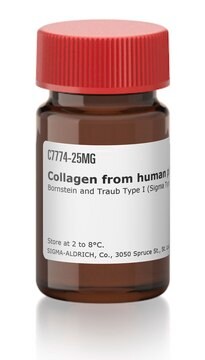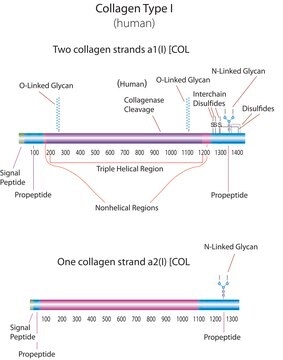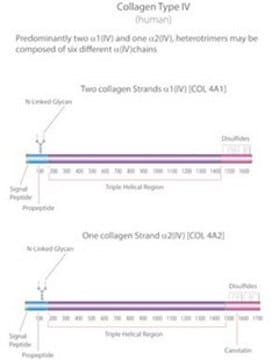C7624
Collagen human
Bornstein and Traub Type I, recombinant, expressed in Nicotiana tabacum (tobacco)
Synonym(s):
Collage™
About This Item
Recommended Products
biological source
human
Quality Level
recombinant
expressed in Nicotiana tabacum (tobacco)
Assay
>90% (SDS-PAGE)
form
liquid
concentration
2.5-3.5 mg/mL protein (Sircol method)
technique(s)
cell culture | mammalian: suitable
shipped in
wet ice
storage temp.
2-8°C
Gene Information
human ... COL1A1(1277) , COL1A2(1278)
Looking for similar products? Visit Product Comparison Guide
General description
Physical form
Preparation Note
To prepare a collagen gel the fibrillogenesis buffer contains 162 mM sodium phosphate dibasic (Na2HPO4) adjusted to pH 11.2 with 10 N NaOH, filter sterilized. Mix 9 volumes of Collagen at a concentration of 0.3%-1% with 1 volume of fibrillogenesis buffer. Mix well and incubate for 4 to 16 hours at 25°C to 27 °C. Higher concentration of collagen solution might need optimization. Thiis preparation will not spontaneously form a gel in PBS or cell culture medium.
Preparation of collagen sponge: concentrate gel to 10 mg/ml - 100 mg/ml by centrifugation, freeze dry. Crosslink by common methods found in the scientific literature such as 1-Ethyl-3-[3-dimethylaminopropyl]carbodiimide hydrochloride (EDC), Glutaraldehyde or thermal dehydration.
Other forms: membranes, sheets, fibers can be prepared by methods commonly used with other types of collagen.
Legal Information
Storage Class Code
13 - Non Combustible Solids
WGK
nwg
Flash Point(F)
Not applicable
Flash Point(C)
Not applicable
Certificates of Analysis (COA)
Search for Certificates of Analysis (COA) by entering the products Lot/Batch Number. Lot and Batch Numbers can be found on a product’s label following the words ‘Lot’ or ‘Batch’.
Already Own This Product?
Find documentation for the products that you have recently purchased in the Document Library.
Customers Also Viewed
Our team of scientists has experience in all areas of research including Life Science, Material Science, Chemical Synthesis, Chromatography, Analytical and many others.
Contact Technical Service







